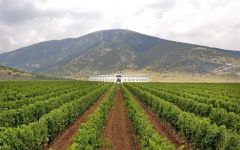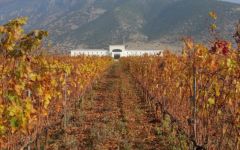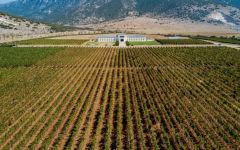Ktima Pavlidis Thema 2015



Product Details
Your Rating
Somm Note
Winemaker Notes
It is seeking the company of grilled red meat and spicy game, as well as spicy and unctuous cheeses. It's a wine with a great potential of aging. It needs to be decanted before serving.
Other Vintages
2017-
Robert
Parker
-
Robert
Parker
-
Robert
Parker







While winemaking in Drama dates back to antiquity, the region did not emerge onto the modern winemaking scene until the 1980s. Ktima Pavlidis was created in 1998 with 160 acres of estate vineyards planted with a mix of international and indigenous Greek varietals. The Ktima Pavlidis winery and vineyards are located in the region of Drama in Eastern Macedonia. This region is surrounded by mountains on three sides, and by the Aegean Sea to the south. This unique topography provides the estate vineyards with a special microclimate, with cool winds during the night that prolong the ripening period and give the grapes the opportunity to ripen slowly and evenly. All wines are made exclusively with estate-grown fruit, in order to control the quality of production. Each of the estate vineyards has an on-site weather station which allows the viticultural team to closely monitor conditions during the growing season, ensuring that grapes are harvested during optimal ripeness. The grapes are hand-harvested at night and refrigerated during transportation in order to take advantage of the cooler temperature and preserve the varietals’ aromatics and natural acidity. At the estate’s modern winemaking facility, the team uses a gentle approach, utilizing light crushing, temperature-controlled maceration and gravity-flow transfers in order the faithfully preserve the characteristics of the grapes without over extraction or harsh tannins. The resulting wines from Ktima Pavlidis are high-quality, terroir-driven wines with enjoyable aromatic and flavor profiles, with a distinct and recognizable personality.

With hundreds of red grape varieties to choose from, winemakers have the freedom to create a virtually endless assortment of blended red wines. In many European regions, strict laws are in place determining the set of varieties that may be used, but in the New World, experimentation is permitted and encouraged resulting in a wide variety of red wine styles. Blending can be utilized to enhance balance or create complexity, lending different layers of flavors and aromas. For example, a red wine blend variety that creates a fruity and full-bodied wine would do well combined with one that is naturally high in acidity and tannins. Sometimes small amounts of a particular variety are added to boost color or aromatics. Blending can take place before or after fermentation, with the latter, more popular option giving more control to the winemaker over the final qualities of the wine.
How to Serve Red Wine
A common piece of advice is to serve red wine at “room temperature,” but this suggestion is imprecise. After all, room temperature in January is likely to be quite different than in August, even considering the possible effect of central heating and air conditioning systems. The proper temperature to aim for is 55° F to 60° F for lighter-bodied reds and 60° F to 65° F for fuller-bodied wines.
How Long Does Red Wine Last?
Once opened and re-corked, a bottle stored in a cool, dark environment (like your fridge) will stay fresh and nicely drinkable for a day or two. There are products available that can extend that period by a couple of days. As for unopened bottles, optimal storage means keeping them on their sides in a moderately humid environment at about 57° F. Red wines stored in this manner will stay good – and possibly improve – for anywhere from one year to multiple decades. Assessing how long to hold on to a bottle is a complicated science. If you are planning long-term storage of your reds, seek the advice of a wine professional.

A picturesque Mediterranean nation with a rich wine culture dating back to ancient times, Greece has so much more to offer than just retsina. Between the mainland and the country’s many islands, a wealth of Greek wine styles exists, made mostly from Greece’s plentiful indigenous varieties. After centuries of adversity after Ottoman rule, the modern Greek wine industry took off in the late 20th century with an influx of newly trained winemakers and investments in winemaking technology.
The climate—generally hot Mediterranean—can vary a bit with latitude and elevation, and is mostly moderated by cool maritime breezes. Drought can be an issue for Greek wine during the long, dry summers, sometimes necessitating irrigation.
Over 300 indigenous grapes have been identified throughout Greece, and though not all of them are suitable for wine production, future decades will likely see a significant revival and refinement of many of these native Greek wine varieties. Assyrtiko, the crisp, saline Greek wine variety of the island of Santorini, is one of the most important and popular white wine varieties, alongside Roditis, Robola, Moschofilero, and Malagousia. Muscat is also widely grown for both sweet and dry wines. Prominent red wine varieties include full-bodied and fruity Agiorghitiko, native to Nemea; Macedonia’s savory, tannic Xinomavro; and Mavrodaphne, used commonly to produce a Port-like fortified wine in the Peloponnese.
